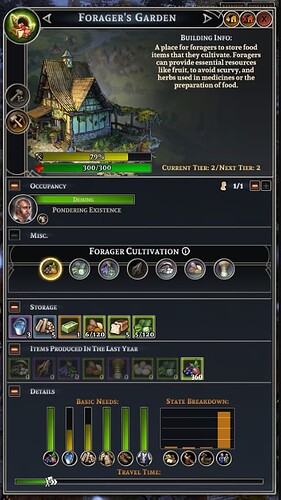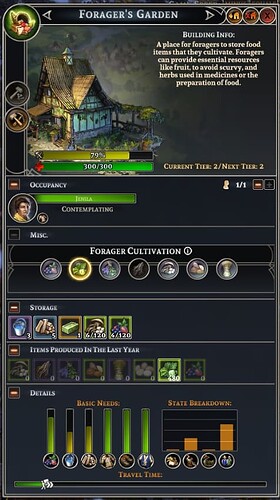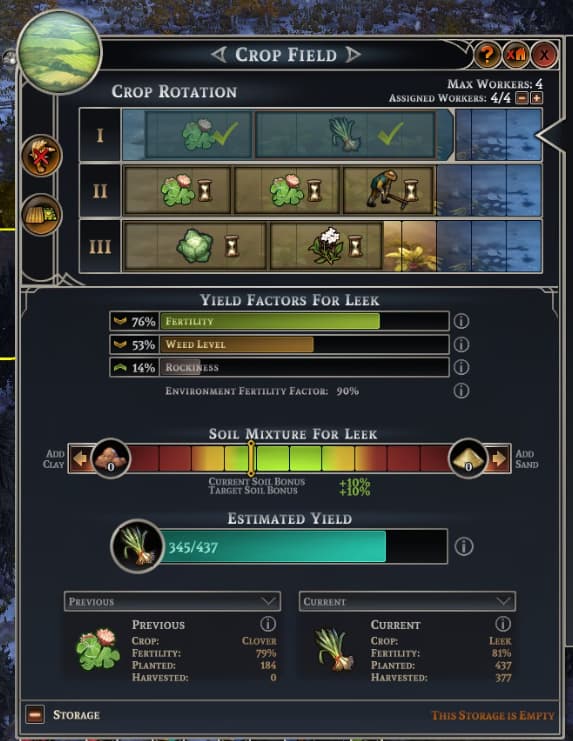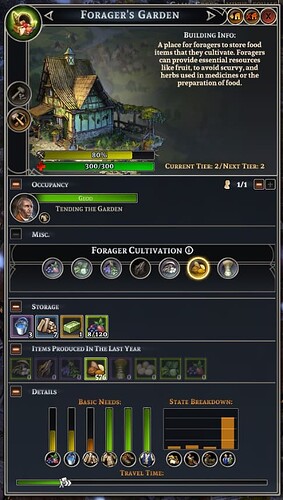There are two things that I think are overtuned about the upgraded forager. First, it’s equivalent to a nearly impossibly large quantity of wild foraging nodes, and second, it’s absurdly space-efficient while simultaneously not caring about land fertility. Of the two, I think the space efficiency is the bigger problem.
The three most interesting things to look at for this purpose are berries (which we can compare against orchards), greens (for a direct farm comparison), and nuts (because they’re shelf-stable). These pictures are from an alpine map, which I am given to understand has a lower productivity for some food types than some other maps might have. I took the pictures during the winter after running the gardens for a couple years so we could be confident we had one year’s harvest.
First, let’s talk about berries. Berries are not one of those food types with reduced productivity on alpine maps. This 360 berries per year is the same as you’d get on, say, lowland lakes:
I forgot to take a picture of one of my orchards, but my experience is that a mixed peach and apple arborist orchard produces 600-1000 fruit when fully staffed, depending on maturity and probably other circumstances like how much fruit random passers-by just pulled off the trees as they walked by. So, to get the productivity of an orchard, you can build two or three of these, which would fit in the space of the arborist and three trees, while my orchards tend to have 40-50 trees.
However, it’s not just around the low end of productivity per person of a mature orchard on good land. Most berry bushes also produce on average about 20 berries a year, so it’s also equivalent to a forager with 18 blueberries transplanted next to it! You could fit four of these in the space that a forager and 18 tightly-packed blueberry bushes takes up. The problem here isn’t necessarily productivity, although I think the orchard part qualifies as too productive; it’s just that it’s absurdly compact.
Moving on to greens, this is one where I’m pretty sure the productivity is reduced from lowland lakes, but I don’t feel like going back to check right now. But anyway, it’s probably even more bonkers there, because I remember greens producing more than nuts (see below) rather than the other way around. Here is a forager garden:
… and here is a 5x5 farm which I recently created and have farming leeks:
There are three things that are upside-down here:
- The garden produces more than the rated output of the leek farm. (It’s probably close to no weeds, no rocks, full fertility, and favorable soil, but that will require waiting awhile, so I’m not sure.)
- The garden uses half to a quarter of the workers. After all, you need more farmers the more productive the field is to get the crops in in time.
- You can fit three gardens in the space of a 5x5 farm with land to spare. Furthermore, animals can’t eat your garden, so a 5x5 farm on its own is more like a 7x7 land plot.
On lowland lakes, the most productive one is greens. It’s more productive than in these pictures! But here on the hillside, the productivity crown goes to nuts, which incidentally also have a generous 18 month spoilage time:
I don’t know if that’s roughly 18 nut foraging locations, because there aren’t that many nuts on my map! I had a lakes map with a couple fantastic wild hazelnut patches, and they didn’t produce much better than this, though, while taking up a lot more space. And this certainly beats the heck out of farming!
Anyway, to sum up, forager gardens are currently far more labor-efficient than farmers for things that directly compete with farming, and they’re far more space-efficient than literally any other food production method. At least one of these things needs to be reduced. I’d love for them to have a work area sort of like livestock. Giving them a fertility mechanic with the work area would also sidestep the fact that they’re apparently magically fertile, too. If it’s not possible to have the type of work area change from one tier of a building to the next, dropping them all the way down something closer to the 6 gathering nodes they display graphically would change them from being absurdly efficient to merely very useful.
Incidentally, It’s interesting to note that the willow output on an alpine map is approximately 6 basic willow nodes, which is still vastly more than I had on this map than before (because there are only 2 forage nodes for it on the entire map), but it doesn’t feel quite as out of balance as the food production.



